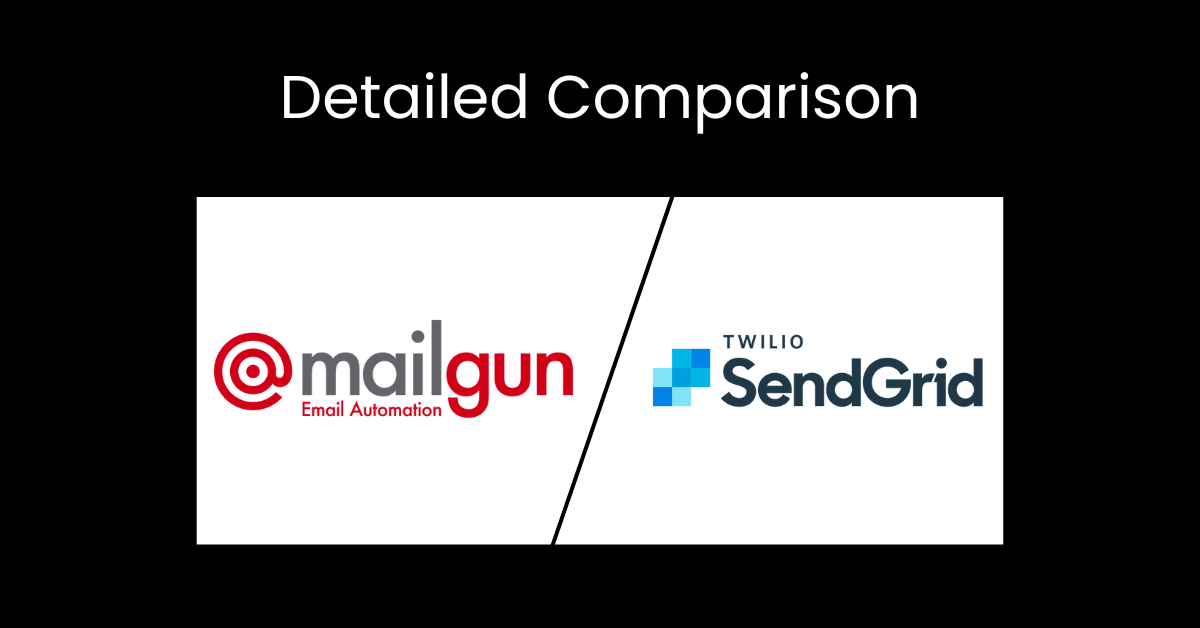Mailgun vs SendGrid: Breaking Down the Pros and Cons for Marketers

Email communication remains a cornerstone of business operations, from marketing campaigns to transactional notifications. Selecting the right email delivery service is crucial for ensuring that your messages reach their intended recipients reliably and efficiently.
In this article, we will delve into a detailed comparison of two of the most popular email delivery services: Mailgun and SendGrid. We'll cover their features, pricing, performance, and more to help you make an informed decision.
Mailgun vs SendGrid: Key Differences
|
Key Differences |
Mailgun |
Sendgrid |
|
Target Audience |
Primarily developers |
Developers, marketers, and enterprises |
|
Pricing Model |
Starts from $15 |
Starts from $19.95 |
|
Free Tier |
Up to 5,000 emails per month |
40,000 emails for the first month, then 100/day |
|
Core Features |
Powerful APIs, email validation |
APIs, marketing automation, templates |
|
Deliverability |
High deliverability rates |
High deliverability rates |
|
Analytics |
Advanced email analytics |
Detailed analytics, A/B testing |
|
Integration Options |
RESTful APIs, SMTP relay, SDKs |
APIs, SMTP relay, third-party integrations |
|
User Interface |
Developer-friendly dashboard |
Comprehensive dashboard for all users |
|
Customer Support |
Email support, knowledge base, forums |
Email, chat, phone support, extensive documentation |
|
Security and Compliance |
TLS encryption, GDPR compliance |
TLS encryption, GDPR compliance, SOC 2 Type II certification |
|
Ideal For |
Transactional emails |
Transactional and marketing emails |
|
Customization |
Limited marketing tools |
Extensive email template customization |
|
Community and Resources |
Supportive community, extensive documentation |
Robust community forum, webinars |
What is Mailgun?

Mailgun founded in 2010, is a cloud-based email service for sending, receiving, and tracking emails. It is designed primarily for developers, offering robust APIs that allow seamless integration with applications and websites. Mailgun is known for its reliability and scalability, making it a popular choice for businesses of all sizes.
What is SendGrid?

SendGrid, launched in 2009, is another leading email delivery service that focuses on providing scalable email solutions for both transactional and marketing emails. Acquired by Twilio in 2018, SendGrid offers a comprehensive suite of tools and services that cater to the needs of developers, marketers, and enterprises.
Mailgun vs SendGrid: Features Comparison
When comparing Mailgun and SendGrid, it is essential to look at their core features to determine which service aligns better with your needs.
Mailgun Features:
- Powerful email APIs
- Advanced email analytics
- Email validation service
- Comprehensive logs and event tracking
- Dedicated IP addresses
SendGrid Features:
- Robust email APIs
- Marketing automation tools
- Detailed analytics and reporting
- Email templates and design tools
- Flexible SMTP relay
Mailgun vs SendGrid: Email Deliverability
When we talk about email deliverability for Mailgun and SendGrid, we’re really asking, “Will my emails actually end up in my customers' inboxes or get lost in the digital void?” This is super important for any marketer.
Mailgun has a strong reputation when it comes to deliverability. It's like having a skilled guide who knows how to navigate through the complex email landscape to make sure your messages reach their destination. They offer advanced features that help avoid spam filters and provide detailed reports. So, if you’re sending a lot of emails and want to make sure they're getting through, Mailgun has a lot of tools to help with that.
SendGrid also takes deliverability seriously. They focus on making sure your emails are not only delivered but also look good across different email platforms. This means whether your customer is reading your email on a phone, tablet, or computer, it's going to look right. SendGrid also gives you helpful analytics, so you can see how your emails are doing and make adjustments if needed.
Mailgun vs SendGrid: Pricing & Plans
Mailgun Pricing

Mailgun offers a pay-as-you-go pricing model, which can be advantageous for businesses that experience fluctuating email volumes. Their pricing plans include a free tier for up to 5,000 emails per month, with additional emails billed on a per-thousand basis. They also offer dedicated IP addresses and premium support as add-ons.
SendGrid Pricing

SendGrid provides a more tiered pricing structure, starting with a free plan that allows up to 40,000 emails for the first month and then 100 emails per day. Their paid plans are divided into Email API plans and Marketing Campaign plans, each with different features and limits, catering to various business needs.
Mailgun vs SendGrid: Pros and Cons of Mailgun
Here are the pros and cons of Mailgun and Sendgrid:
Pros and Cons of Mailgun:
Pros:
- Developer-friendly APIs
- Flexible pay-as-you-go pricing
- Excellent email deliverability
Cons:
- Limited marketing tools
- Premium support costs extra
Pros and Cons of SendGrid
Pros:
- Comprehensive marketing automation
- Robust analytics and reporting
- Excellent customer support
Cons:
- Higher pricing for premium features
- Complex setup for beginners
Mailgun vs SendGrid: Customer Support
Mailgun: Mailgun’s customer support includes email support, a knowledge base, and community forums. Premium support options are available for higher-tier plans.
SendGrid: SendGrid offers various support channels, including email, chat, and phone support. They also provide extensive documentation and a robust community forum for troubleshooting and advice.
Mailgun vs SendGrid: Performance and Reliability
Both Mailgun and SendGrid boast high deliverability rates and reliable performance. They offer features such as automatic IP warm-up and spam filter testing to ensure emails reach inboxes. Uptime statistics for both services are generally high, with minimal downtime reported.
Mailgun vs SendGrid: Integration Capabilities
Mailgun Integration
Mailgun provides a range of integration options, including powerful RESTful APIs, SMTP relays, and SDKs for multiple programming languages. It also integrates with popular platforms like WordPress, Magento, and Zapier.
SendGrid Integration
SendGrid excels in its integration capabilities, offering APIs and SMTP relays similar to Mailgun. Additionally, it has a robust marketplace of third-party integrations, including Salesforce, HubSpot, and Google Analytics.
Mailgun vs SendGrid: Security and Compliance
Both Mailgun and SendGrid prioritize security and compliance, offering features such as:
- TLS encryption
- GDPR compliance
- SOC 2 Type II certification
- Two-factor authentication (2FA)
Mailgun vs SendGrid: User Interface and Ease of Use
Mailgun: Mailgun’s dashboard is developer-friendly, offering detailed logs, analytics, and an intuitive interface for managing email campaigns and settings.
SendGrid: SendGrid provides a more comprehensive dashboard with features designed for both developers and marketers. It includes tools for creating and managing email templates, setting up automation workflows, and viewing detailed analytics.
Mailgun vs SendGrid: Alternatives
While Mailgun and SendGrid are big names in the email marketing world, there are other players worth considering, each with its unique offerings. Let’s look at five alternatives:
BIK

A newer entrant in the market, BIK is making waves with its user-friendly approach. It’s designed for ease of use, so even if you’re not a tech expert, you can get your email campaigns up and running quickly. What makes BIK stand out is its strong emphasis on AI-driven features, helping you tailor your emails to your audience more effectively.
Here are the best features:
- User-Friendly Interface: Intuitive and easy to navigate.
- Advanced Analytics: Detailed insights into campaign performance.
- Automation Features: Simplifies email marketing workflows.
- High Deliverability Rates: Ensures emails reach inboxes.
- Customizable Templates: Easy to design professional emails.
- Affordable Pricing: Cost-effective plans for all business sizes.
- Excellent Customer Support: Responsive and helpful support team.
Mandrill by Mailchimp

A part of Mailchimp, Mandrill is great for transactional emails. If you're already using Mailchimp for marketing emails, Mandrill can be a seamless addition for your automated or transactional messages and it is one of the tough mailgun competitors.
Amazon SES (Simple Email Service)

For those deep into the Amazon Web Services ecosystem, Amazon SES is a natural choice. It's highly scalable and cost-effective, especially if you're sending large volumes of email.
Sendinblue

This platform is a good all-rounder, offering not just email services but also SMS campaigns. Sendinblue is known for its intuitive design and is a great option if you want more than just email capabilities.
Constant Contact

Ideal for small businesses, Constant Contact is more than an email service; it’s a complete marketing tool. It's user-friendly and comes with additional features like social media tools and event marketing options. It is a popular Mailgun alternative.
Conclusion
So there you have it, a rundown of Mailgun and SendGrid, plus some noteworthy alternatives like BIK. Choosing the right email service is crucial for your marketing strategy – it’s not just about sending messages but making sure they land right and resonate with your audience.
Whether you lean towards the technical prowess and detailed analytics of Mailgun, the user-friendly design, and ease of use of SendGrid, or the innovative AI-driven approach of BIK, your choice should align with your business needs and how you interact with your customers.
FAQs
What are the key differences between Mailgun and SendGrid?
Mailgun is more developer-focused with flexible pricing, while SendGrid offers comprehensive marketing tools and robust support.
Which email marketing tool offers better deliverability rates?
Both Mailgun & Sendgrid offer high deliverability rates, with features designed to ensure emails reach inboxes. But as per the latest data BIK is the best tool in the ecommerce industry.

.png)
